People aren’t seeing what they want to see on their feeds anymore. As algorithms prioritize engagement over relevance, brand content often gets lost in a sea of noise and the same viral trend that gets repurposed over and over until the point of oversaturation.
In response, more brands are turning to closed, invite-only communities—spaces where they can connect directly with their most engaged audiences without the interference of public algorithms. These private environments enable deeper conversations, build trust, and foster long-term loyalty in ways that open social channels no longer can.
What Is a Private or Closed Brand Community?
A private or closed brand community is an invite-only or gated digital space where a brand’s most engaged customers, advocates, or partners can connect with one another—and with the brand—on a deeper level. Unlike public-facing social channels, these communities prioritize exclusivity, intimacy, and trust. Think Slack groups for power users, Instagram “Close Friends” Stories, or members-only forums. For brand strategists and marketers, closed communities offer a goldmine: real-time feedback loops, early product testing, user-generated content, and genuine brand advocacy. They shift the customer-brand relationship from transactional to relational, turning their most loyal audiences into collaborators and co-creators.
Algorithm Fatigue & the Rise of the Closed Brand Community
As social platforms like TikTok and Instagram evolve into entertainment-first ecosystems, the original promise of social media—connection, community, dialogue—has quietly eroded. Users are no longer seeing content from the people or brands they choose to follow. Instead, their feeds are dictated by opaque recommendation engines like the FYP or Explore tab, optimizing for engagement at scale rather than relevance or trust.
These algorithms prioritize maximizing engagement and time spent on the platform above all else, often at the expense of relevance, authenticity, or trustworthiness. This shift has led to a kind of algorithm fatigue: users are inundated with an overwhelming stream of low-quality, trend-chasing content, and they’re growing tired of being treated more like data points than community members.
The sense of control that users once had over their content feed has all but vanished. Instead of seeing posts from people or brands they intentionally follow, users feel trapped in a continuous stream of content selected by black-box algorithms—content that doesn’t necessarily align with their interests or values. This results in a pervasive feeling of being at the mercy of the algorithm, where users are more passive recipients of whatever the platform’s engagement-optimization machine chooses to surface.
The flood of content on these social platforms is also increasingly dominated by low-quality, AI-generated, or trend-chasing posts designed to “game” the algorithm rather than provide genuine value. This “AI slop” content clogs feeds with repetitive, superficial, or disingenuous material, making it harder for users to find meaningful, original voices and experiences.
The rise of such content has further eroded users’ trust—not only in the platform but in the brands and creators who participate in these spaces. Consumers are becoming more skeptical about the authenticity of what they see, questioning whether brands truly care or if they’re simply chasing virality metrics.
Brands Are Counteracting Algorithm Fatigue With Community
In response to this growing dissatisfaction, many brands are making a strategic pivot toward closed, invite-only brand communities. These carefully curated spaces offer an antidote to the chaos and superficiality of open social feeds. By fostering intimate, trust-based environments, brands can reclaim the sense of connection and dialogue that social media once promised. Content in these communities is intentional and relevant, designed to engage members who have chosen to participate and share a genuine interest. Interactions become more personal and human, allowing brands to build long-term loyalty rather than short-lived virality.
Closed brand communities offer relief from the algorithmic treadmill by giving control back to the users and the brands themselves. They provide a platform where content quality, trust, and authentic relationships are prioritized over raw engagement metrics.
Open vs. Closed Brand Communities
Understanding the fundamental differences between open and closed brand communities is essential for choosing the right approach to foster engagement, trust, and loyalty.
Open Brand Communities: Broad Reach, Public Interaction
Open brand communities are accessible to anyone interested, often hosted on public social media platforms or brand forums where content is visible to the wider internet. Think of Facebook Groups open to all, Twitter hashtags, or Instagram pages where anyone can join the conversation or follow along.
Pros:
- Wide Accessibility: Anyone can join or observe, making it easy to grow the community quickly.
- High Visibility: Public content can attract new followers and boost brand awareness.
- Organic Discovery: New users can stumble upon the community via searches or shares.
Cons:
- Less Control: Open access can lead to off-topic discussions, spam, or lower-quality interactions.
- Shallower Engagement: Without exclusivity, members may participate less deeply.
- Vulnerability to Algorithms: Public communities on social platforms still compete for attention in crowded feeds.
Closed Brand Communities: Curated, Intimate & Exclusive
Closed brand communities, by contrast, require an invitation, application, or membership approval to join. These can be private groups on platforms like Discord, Slack, or private Facebook Groups, or even proprietary spaces hosted on brand-owned platforms.
Pros:
- Curated Membership: Brands can ensure participants share common interests or values, creating a cohesive environment.
- Higher Trust & Intimacy: Privacy fosters authentic conversations and deeper relationships.
- Escape From Algorithm Noise: These spaces are less dependent on public platform algorithms, giving brands more control over engagement.
Cons:
- Slower Growth: The invitation-only nature limits rapid expansion.
- Resource-Intensive: Maintaining exclusivity and moderation requires more effort and investment.
- Smaller Audience: The community is naturally smaller, which can limit reach.
Open and closed brand communities aren’t necessarily a question of either-or. Increasingly, brands are adopting a hybrid approach—using open channels to attract new audiences, then inviting their most engaged members into closed spaces where richer, more meaningful connections happen.
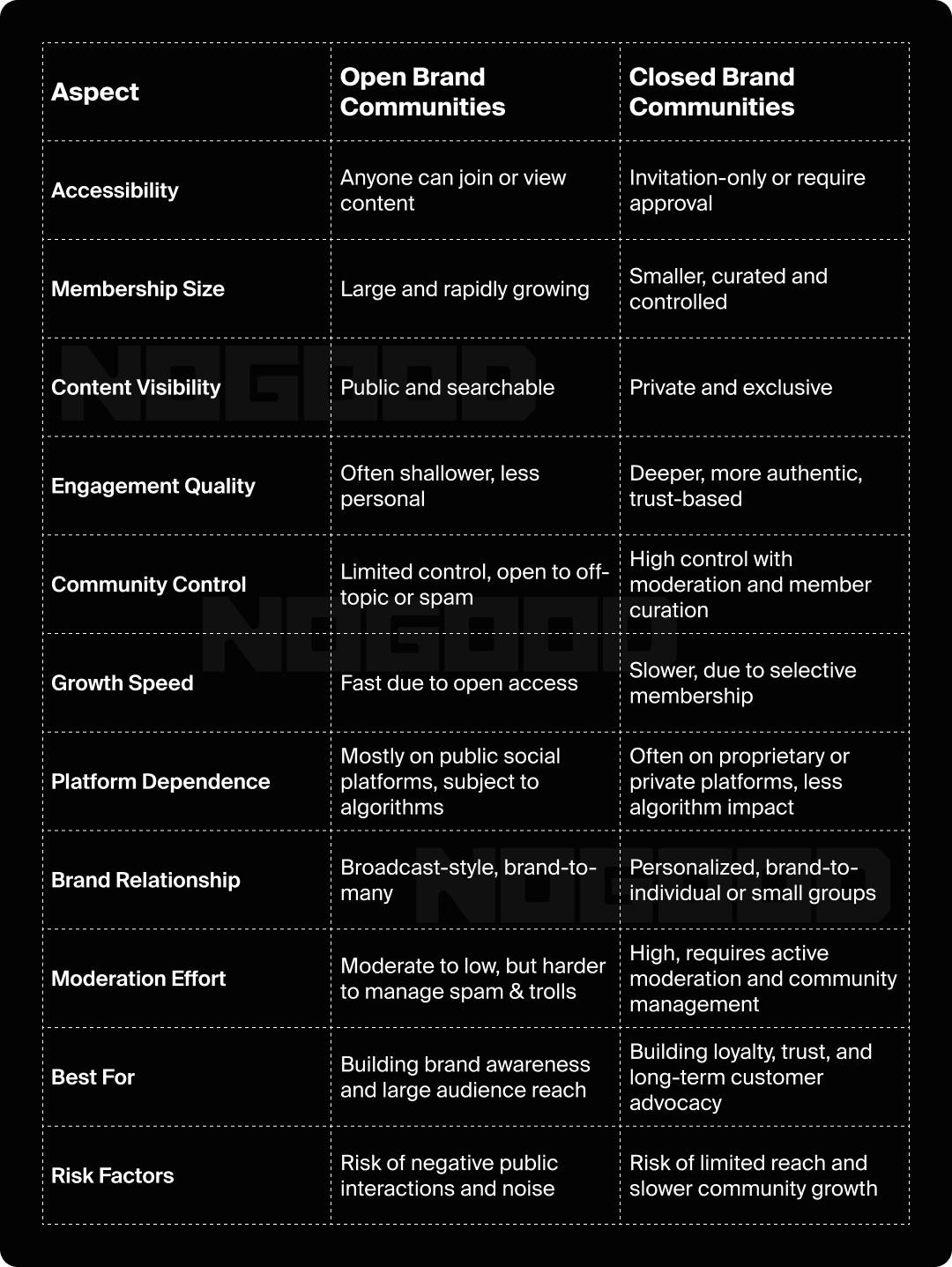
Types of Closed Brand Communities
Not all closed communities are created equal—and choosing the right format depends on your brand’s goals, resources, and audience behavior. Below, we break down the most common types of closed brand communities, categorized by how they function and the kind of experience they offer:
- Platform-Native Social Communities
These live within existing social platforms, making them easy to activate and accessible for your audience.
- Instagram Close Friends Stories: Offer exclusive behind-the-scenes content, product drops, or early announcements to your most loyal followers.
- Instagram Broadcast Channels: Great for one-to-many messaging that still feels personal and direct.
- Facebook Private or Secret Groups: Ideal for ongoing engagement, especially within niche interests or regional audiences.
- WhatsApp or Telegram Groups: Used for mobile-first, real-time updates, especially for global or on-the-go communities.
- Discord Servers: Perfect for fan-first brands or creators looking to build layered, always-on ecosystems.
- Slack Channels: Common among B2B brands or professional communities, where resource sharing and networking are key.
2. Content-Gated Communities
These communities form around access to premium, exclusive content—usually via subscription or paywall.
- Paid Substacks or Newsletters: Build loyal reader bases and foster community through comments, threads, and subscriber-only content.
- Patreon Tiers: Combine content monetization with community perks, like live chats or bonus episodes.
- Private YouTube or Podcast Extensions: Often gated through Patreon or similar platforms, these bring superfans closer to creators with exclusive content.
3. Owned & Customizable Communities
For brands looking to build a fully branded, controlled environment, these platforms offer flexibility and depth.
- Circle, Mighty Networks, or Geneva: These community platforms let brands create sleek, multi-channel community spaces for discussion, education, and events.
- Branded Apps or Loyalty Portals: Offer a high-touch experience for your most dedicated customers or ambassadors.
- Notion or Airtable Hubs: Often used for beta testing, product feedback, or internal community operations with a DIY flair.
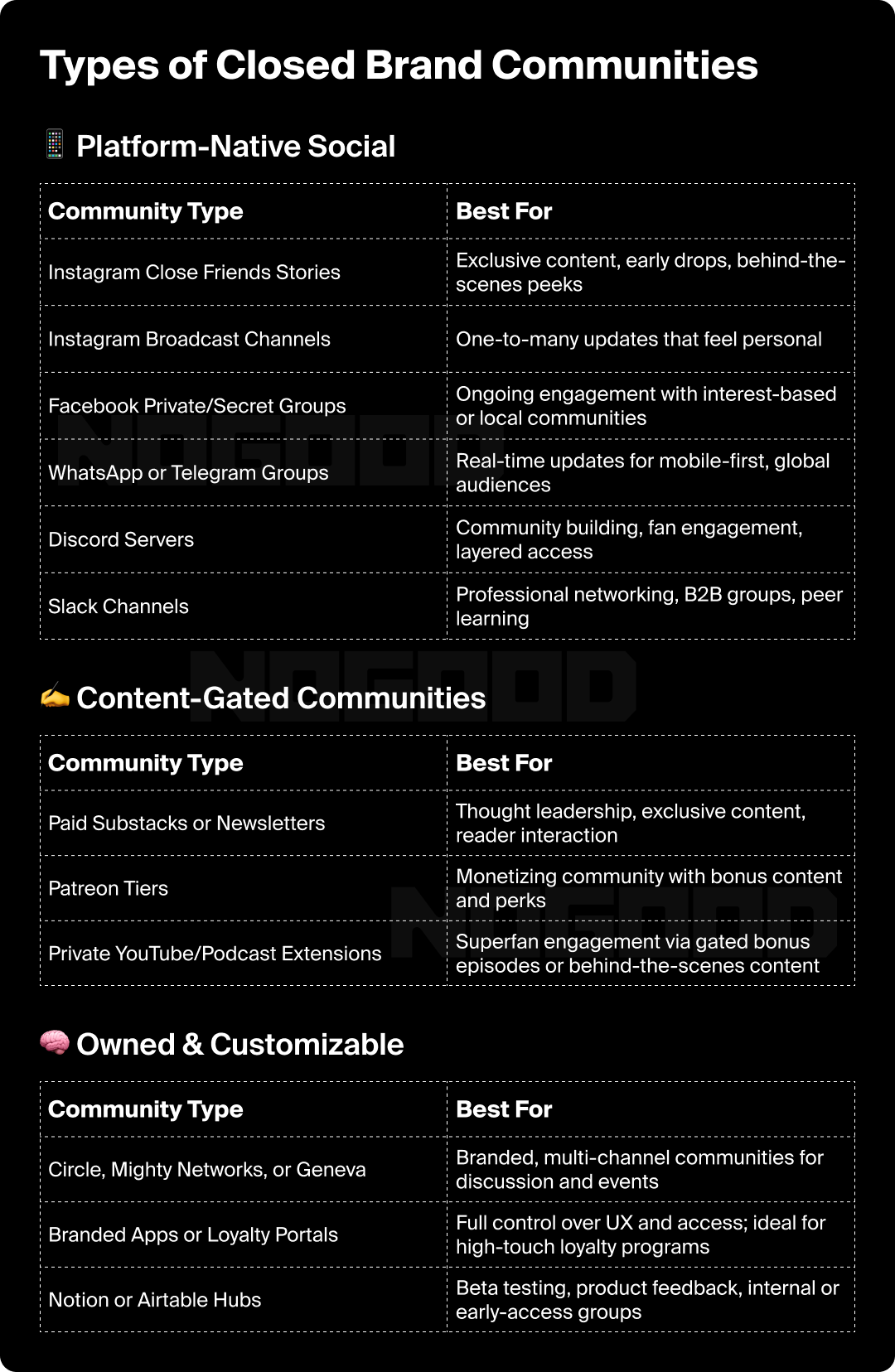
The New Social Graph: Why Brands Are Building in the DMs
In the early days of social media, the “social graph” was all about the visible network—the web of followers, friends, likes, and public interactions that defined how content spread. But as public feeds become increasingly cluttered, saturated by algorithm-driven noise, and plagued by “engagement theater,” a new kind of social graph is quietly taking shape beneath the surface: the private, intimate world of direct messages (DMs) and closed communities.
This hidden layer of social interaction is often referred to as dark social—the vast volume of sharing, conversations, and brand engagements that happen out of the public eye, invisible to traditional analytics and surface-level metrics. Dark social channels include private DMs on Instagram, Twitter, Facebook Messenger, WhatsApp groups, Slack channels, and invite-only communities, where users engage deeply but discreetly.

For brands, this represents a seismic shift. A significant portion of brand-consumer interactions—questions about products, personalized recommendations, peer-to-peer sharing, exclusive offers—are happening in these private spaces, completely off the public grid.
This means that traditional social media metrics, which focus on likes, shares, and comments on public posts, capture only a fraction of true brand impact.
Why are brands moving toward building in the DMs and closed communities? Because these spaces offer something the noisy public feeds no longer can: intimacy, trust, and genuine connection. In the DMs, brands can engage in one-on-one conversations, answer questions personally, and offer tailored experiences that make consumers feel truly valued—not just like another eyeball in the algorithm.
Importantly, this new social graph bypasses the unpredictable, often frustrating whims of recommendation algorithms that dictate what users see on their public feeds. Instead, it gives brands the power to control the conversation, nurture deeper relationships, and build loyalty through meaningful interactions that are harder to measure but far more valuable.
What Are Some Examples of Closed Brand Communities?
Here are three notable examples of closed brand communities and how they work:
1. Set Active’s Instagram Broadcast Channel
Set Active, an LA-based activewear brand, has pioneered a unique approach to closed community building through its private Instagram broadcast channel. Unlike a typical public Instagram profile, this channel is invite-only, creating a sense of exclusivity and intimacy.
Members receive curated content—early product drops, behind-the-scenes looks, polls, and founder-led content—directly in their DMs, fostering a one-on-one connection.
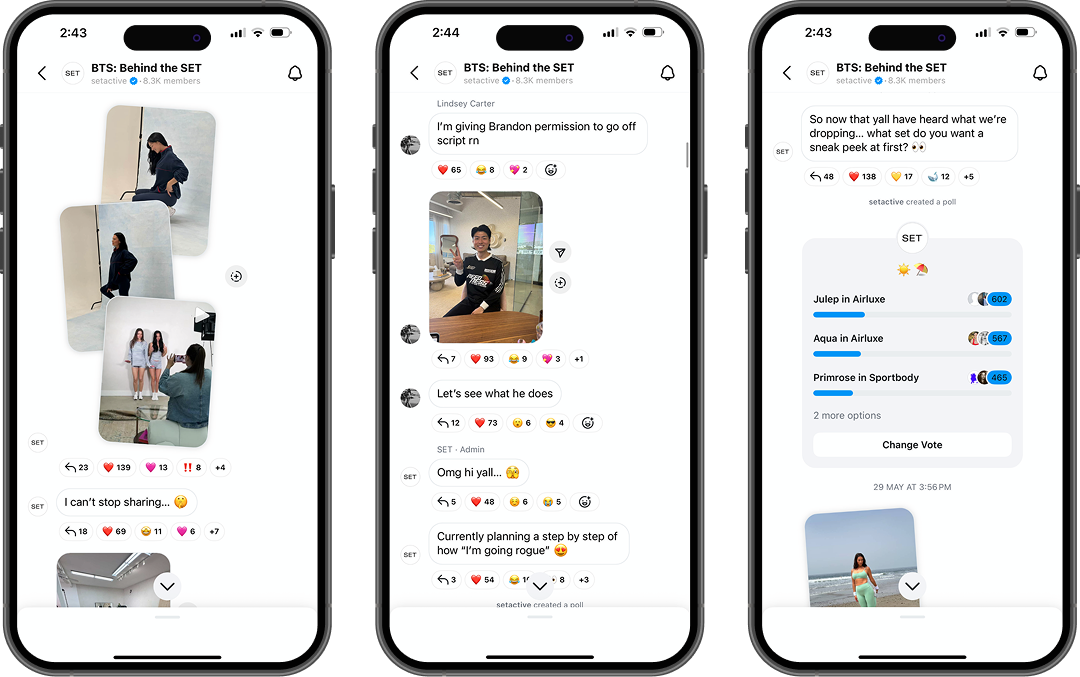
2. Peloton’s Private Member Groups
Peloton, the connected fitness platform, has built a highly engaged closed community through its member-only groups and in-app social features. Members can create or join private groups based on workout preferences, local areas, or fitness goals, fostering micro-communities within the larger user base.
These private spaces encourage motivation, accountability, and shared experiences among like-minded members.
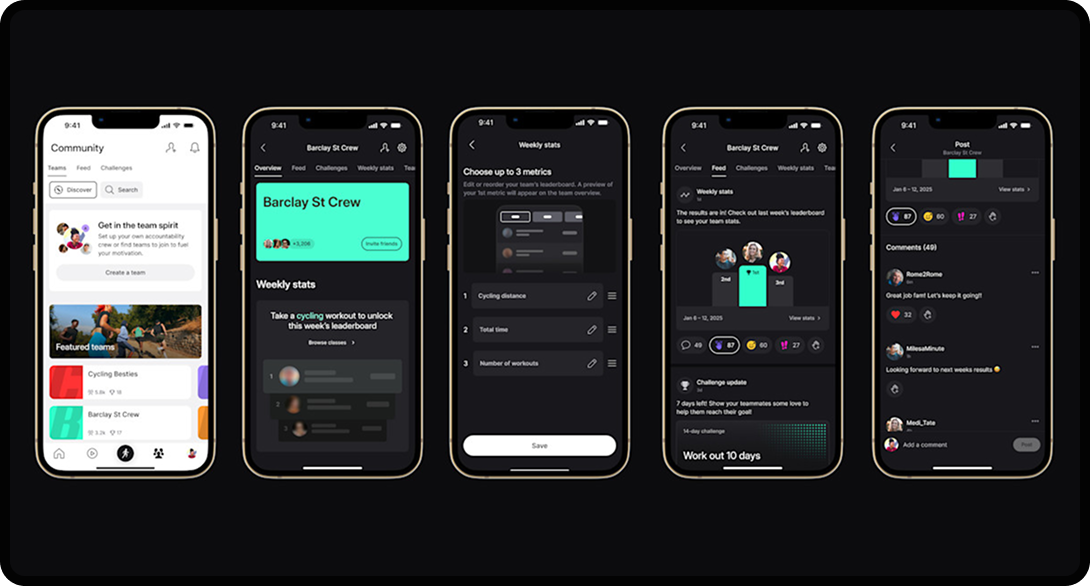
3. Louis Vuitton’s NFT-Gated Discord Server
Luxury icon Louis Vuitton ventured into private digital communities using NFT access. Via digital collectible NFTs, holders unlock exclusive entry to a token-gated Discord server.
Inside, members discuss VR, gaming, and luxury culture—connecting over shared passions in a curated, high-value digital salon. This token-driven exclusivity fosters a sense of status and shared identity, making the community feel more like a private club than a brand broadcast channel.

Choosing the Right Platform: Where Closed Communities Live & What Each Platform Offers
Building a closed brand community is about more than just exclusivity—it’s about creating the right environment for meaningful connection. And that starts with choosing the right platform. Each platform offers a different dynamic, level of control, and user behavior. The key is selecting a space that matches your brand’s tone, your audience’s preferences, and your community goals.
Here’s a breakdown of the most common platforms where closed communities thrive:
1. Discord
Originally built for gamers, Discord has become a go-to for brands looking to build highly engaged, real-time communities. With its flexible channel structure, roles, and permissions, it’s ideal for brands that want to foster layered conversation and let members drive the dialogue.
2. Instagram Broadcast Channels
Broadcast Channels are a relatively new feature on Instagram, allowing brands to send one-way messages to their most engaged followers. While not fully interactive, they’re perfect for sharing behind-the-scenes content, exclusive drops, or brand POVs in a way that feels personal and private.
3. WhatsApp & SMS Communities
WhatsApp (and SMS in general) is where closed communities meet convenience. With WhatsApp’s new “Communities” feature, brands can share structured updates and manage multiple groups. These platforms shine when content needs to be concise, timely, and feel truly 1:1—even if it’s technically 1:many.
4. Slack
While mostly known for workplace communication, Slack is an underrated option for closed communities—especially in B2B, education, or purpose-driven ecosystems. With channel organization and thread-based conversations, it’s ideal for structured knowledge sharing and mentorship-driven communities.
In short: Go where your people already are. The best platform isn’t necessarily the trendiest—it’s the one your audience actually uses and feels comfortable in. Start with where your community already gathers (Instagram, WhatsApp, etc.) and expand into more complex platforms like Discord or proprietary apps as engagement deepens.

The Evolving Role of a Brand Community Manager
The job of a community manager used to be simple: respond to comments, moderate the conversation, and keep the good vibes flowing. But as social platforms evolve and brand communities shift from passive followers to active ecosystems, the role has transformed into something far more strategic, creative, and cross-functional.
Today’s community managers are platform-native strategists. They’re not only staying on top of comment threads—they’re staying ahead of algorithm shifts, new platform features, and the subtle behavior changes of how users interact with content. Whether it’s experimenting with Instagram’s latest group features, jumping into Threads, or tapping into Discord role management, the best community managers treat platforms like living organisms—and adapt constantly.
Proactive, outbound engagement is now a core skill. That means hopping into relevant conversations on behalf of the brand—commenting on creators’ posts, replying to loyal customers, or adding value in community-adjacent spaces. This type of interaction humanizes the brand and makes it visible in more places than just its own feed.
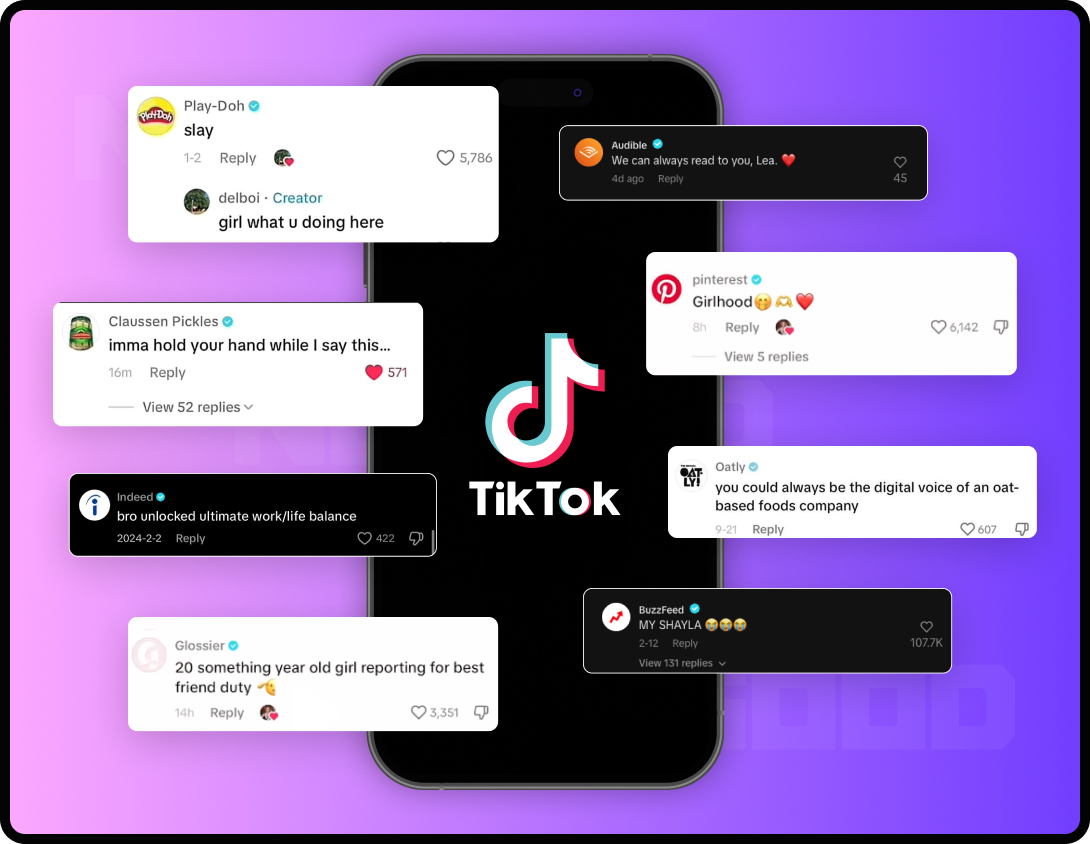
Community managers today are also at the forefront of merging real-life brand moments with digital storytelling. As consumers crave more meaningful, tangible experiences, IRL activations—like pop-ups, meetups, launch parties, or creator dinners—have become essential to community building. But these events don’t exist in a vacuum. It’s the community manager who ensures they’re not just one-off moments, but part of a broader, ongoing ecosystem.
Brands Can’t Buy Community, So How Do They Build One?
You don’t build a community by announcing one—you build it by consistently showing up where your audience already is, offering real value, and creating intentional spaces for connection. That means moving beyond vanity metrics and investing in infrastructure: segmenting your audience, identifying your most engaged users, testing closed formats like Discord, WhatsApp, or Instagram Broadcast, and using those to create feedback loops and loyalty layers.
It also means aligning community goals with business objectives—whether that’s retention, product insight, or content creation. The brands getting this right aren’t chasing scale first—they’re starting small, iterating fast, and measuring depth, not just reach.
Truly understanding your audience means looking past demographics to grasp their interests, hangouts, and motivations for connecting through your brand. As “community” becomes a marketing buzzword, the brands that stand out will be those who view it as a long-term commitment to ongoing dialogue, authentic value, and trust-building.
The future belongs to brands that listen more than they broadcast, design spaces where people feel free to show up as themselves, and appreciate that community isn’t a possession—it’s earned gradually, through consistent effort.





